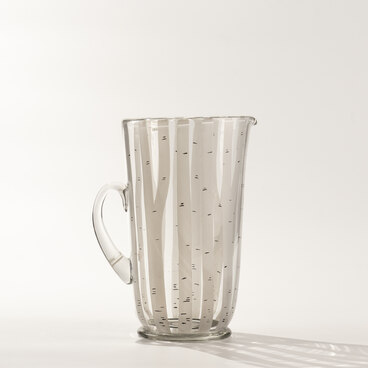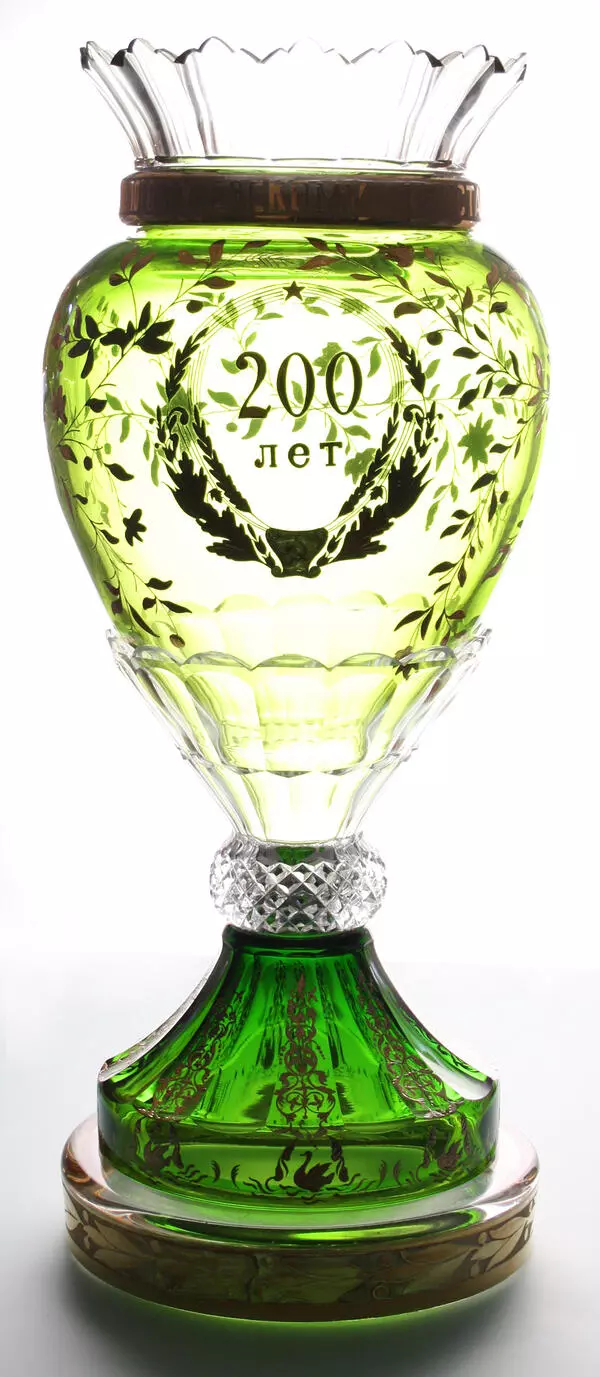The decorative vase “60th Anniversary of the USSR” is one of the numerous large vases made by the artist Yevgraf Shuvalov who worked at the Dyatkovo Crystal Factory for 47 years. During that time, he developed around 500 types of glass and crystal products, with over 100 million items produced based on his patterns. There is an entire large hall on the second floor of the Crystal Museum dedicated to the work of Yevgraf Shuvalov that houses around 2,500 items.
The significant contribution of Yevgraf Shuvalov to the development of Russian glass art was duly appreciated: in 1969, he was awarded the title of the Honored Artist of the Russian Soviet Federative Socialist Republic (RSFSR), in 1977 — the People’s Artist of the RSFSR, and in 1983 — the Ilya Repin RSFSR State Prize.
This vase is dedicated to the 60th anniversary of the Soviet Union. It consists of five parts made of crystal and colored glass (selenium ruby). Crystal is highly transparent glass that includes lead oxide. Lead gives the glass its distinctive gloss finish and ringing sound.
The selenium ruby glass is obtained by painting glass mass with selenium and cadmium compounds. By adjusting the ratio of these compounds, various bright shades of red are achieved. The deep etching technique was used to add the state emblem of the USSR and a ribbon with laurel branches to the vase’s body. The vase is also decorated using deep cutting patterns such as “an elaborate star”, “a snowflake on a stone”, “a pit”, and “a finger”. The deep cutting technique is used to apply images when the glass is cold. The deep grooves of the pattern are made using a special tool. This technique was first developed in England in the 1780s. Initially, the image looks dull and dim. The distinctive gloss is achieved by polishing the product with a mixture of sulfuric and hydrofluoric acid.
The vase is tall, with the central part flaring at the top. The combination of the transparent crystal, scarlet glass, and the large pattern is intended to reflect the atmosphere of this festive anniversary.
The significant contribution of Yevgraf Shuvalov to the development of Russian glass art was duly appreciated: in 1969, he was awarded the title of the Honored Artist of the Russian Soviet Federative Socialist Republic (RSFSR), in 1977 — the People’s Artist of the RSFSR, and in 1983 — the Ilya Repin RSFSR State Prize.
This vase is dedicated to the 60th anniversary of the Soviet Union. It consists of five parts made of crystal and colored glass (selenium ruby). Crystal is highly transparent glass that includes lead oxide. Lead gives the glass its distinctive gloss finish and ringing sound.
The selenium ruby glass is obtained by painting glass mass with selenium and cadmium compounds. By adjusting the ratio of these compounds, various bright shades of red are achieved. The deep etching technique was used to add the state emblem of the USSR and a ribbon with laurel branches to the vase’s body. The vase is also decorated using deep cutting patterns such as “an elaborate star”, “a snowflake on a stone”, “a pit”, and “a finger”. The deep cutting technique is used to apply images when the glass is cold. The deep grooves of the pattern are made using a special tool. This technique was first developed in England in the 1780s. Initially, the image looks dull and dim. The distinctive gloss is achieved by polishing the product with a mixture of sulfuric and hydrofluoric acid.
The vase is tall, with the central part flaring at the top. The combination of the transparent crystal, scarlet glass, and the large pattern is intended to reflect the atmosphere of this festive anniversary.






